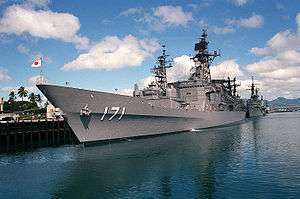Hatakaze-class destroyer
The Hatakaze class of guided missile destroyers is a third generation class of vessels in service with the Japan Maritime Self-Defense Force (JMSDF). They were the first of the JMSDF's ships to have gas-turbine propulsion.
 Hatakaze (DDG-171) docked in Pearl Harbor, 1988 | |
| Class overview | |
|---|---|
| Name: | Hatakaze class |
| Builders: | Mitsubishi Heavy Industries |
| Operators: |
|
| Preceded by: | Tachikaze class |
| Succeeded by: | Kongō class |
| Cost: |
|
| Built: | 1983–1988 |
| In commission: | 1986–present |
| Completed: | 2 |
| Active: | 2 (1) |
| General characteristics | |
| Type: | Guided missile destroyer |
| Displacement: |
|
| Length: | 150 m (492 ft 2 in) |
| Beam: | 16.4 m (53 ft 10 in) |
| Draft: | 4.8 m (15 ft 9 in) |
| Propulsion: |
|
| Speed: | 30 knots (35 mph; 56 km/h) |
| Complement: | 260 |
| Armament: |
|
The core weapon suite is similar to that of the preceding Tachikaze class, but various improvements were made in many areas. Most notable are those that allow the Hatakaze class to function as a group flagship. Normally this duty resides with a larger type of ship, but in case of their absence due to repairs, accident, or battle damage, the Hatakaze design allows for it to function as a command ship.
Hatakaze destroyers operate the OYQ-4-1 type tactical control system. Its weapon systems include the Standard missile surface-to-air missile, anti-submarine rockets, the RGM-84 Harpoon anti-ship missile, two Mark 15 20 mm CIWS gun mounts, two torpedo mounts in a triple tube configuration and two 5 inch/54 caliber Mark 42 rapid-fire guns.
Namesakes
Hatakaze was also the name of a pre–World War II destroyer of the Kamikaze class. Commissioned on 1 August 1924, Hatakaze was finally sunk by aerial attack on 15 January 1945.
The name Shimakaze was also shared by two Imperial Japanese Navy destroyers. The first one was part of the Minekaze-class. This Shimakaze was sunk by a submarine in January 1943. The second one of 3048 tons, was a super-destroyer built at Maizuru Shipyards in Japan. She was completed in May 1943, being extremely large and fast, with a very heavy torpedo armament. This Shimakaze was sunk by U.S. Navy carrier-based aircraft in the Philippines area on 11 November 1944, along with three other destroyers in the Ormoc Bay area, while escorting troop transports to the vicinity.
Ships in the class
| Building no. | Pennant no. | Name | Laid down | Launched | Commissioned | Home port | Note |
|---|---|---|---|---|---|---|---|
| 2311 | DDG-171 TV-3520 | Hatakaze | 20 May 1983 | 9 November 1984 | 27 March 1986 | Yokosuka | Converted to training vessel (TV-3520) on 19 March 2020 |
| 2312 | DDG-172 | Shimakaze | 13 January 1985 | 30 January 1987 | 23 March 1988 | Maizuru |
References
External links
| Wikimedia Commons has media related to Hatakaze class destroyers. |